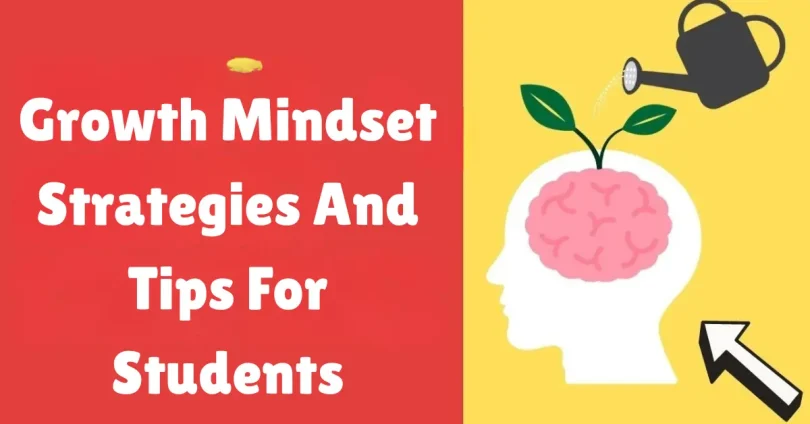You’ve probably heard about a growth mindset. Psychologist Carol Dweck explains it as the belief that your intelligence and skills can grow with effort and practice. Unlike a fixed mindset, which makes people think, “I’m just not good at this,” a growth mindset encourages learning from mistakes and embracing challenges.
Research shows that fostering a growth mindset strategies and tips for students can make them more resilient, motivated, and likely to reach their full potential. Think of it like learning to ride a bike: you may fall at first, but every attempt builds confidence and skill. Let’s explore practical strategies to help students thrive in school and beyond.
1. Embrace Challenges as Opportunities

One of the core principles of a growth mindset is seeing challenges not as obstacles but as opportunities to grow. Many students shy away from difficult assignments or avoid subjects they find intimidating. But growth-minded students approach challenges with curiosity and a desire to learn.
Why it matters: Each challenge you face is a chance to build skills, develop problem-solving abilities, and increase your confidence. Avoiding difficult tasks might feel safe, but it limits growth.
Practical Tip: When you encounter a tricky problem or topic, repeat to yourself, “I might not get it yet, but I can improve with practice and effort.” This simple shift in thinking changes your approach from fear to curiosity.
2. Learn from Mistakes
Mistakes are not failures—they’re learning tools. Students with a growth mindset understand that errors provide critical insights into what doesn’t work and how to adjust strategies. Instead of feeling defeated by mistakes, they analyze what went wrong and use that knowledge to improve.
Why it matters: Mistakes encourage self-reflection and critical thinking. They help students identify weaknesses, adapt their methods, and ultimately master the material.
Practical Tip: Keep a “learning journal” where you note down mistakes and key takeaways. For example, if you got a math problem wrong, write down why and how you’ll approach similar problems differently next time. This reinforces the belief that growth comes from effort and reflection.
3. Focus on Effort, Not Just Results
A growth mindset emphasizes the process over the outcome. Many students focus solely on grades, which can create stress and fear of failure. Growth-minded students, however, celebrate effort, perseverance, and the strategies they use to tackle tasks.
Why it matters: Focusing on effort helps students stay motivated even when immediate results aren’t perfect. It reinforces the idea that improvement is a journey.
Practical Tip: Celebrate small wins. Instead of thinking, “I’m just bad at science,” remind yourself, “I practiced hard today and improved my understanding of this topic.” Recognizing effort encourages consistent progress.
You may also like to read this:
12 Best Free Mobile Scanning Apps For iOS & Android
12 Free Online Marketing Certification Courses List 2025
15 Practical Beginner Tips To Learn Python For Data Science
10 Best Types of Educational YouTube Channels For Learning
13 Top Free Online Project Management Courses 2025
4. Develop Positive Self-Talk
The way students speak to themselves greatly influences their mindset. Negative self-talk like “I can’t do this” or “I’m not smart enough” reinforces a fixed mindset. Positive self-talk, on the other hand, builds confidence and encourages persistence.
Why it matters: Positive self-talk reduces stress and increases resilience. It helps students tackle challenges with a proactive attitude rather than fear or avoidance.
Practical Tip: Use affirmations daily, such as “I can learn anything I put effort into” or “Every mistake is a chance to grow.” Over time, these positive statements reshape your mindset.
5. Set Learning Goals Instead of Performance Goals
Students often focus solely on grades or test scores, which are performance goals. Growth-minded students, however, set learning goals, which emphasize acquiring knowledge, mastering skills, and improving gradually.
Why it matters: Learning goals promote deeper understanding, reduce anxiety about grades, and encourage long-term success.
Practical Tip: Replace “I want an A on this test” with “I will master these five key concepts before the exam.” This focuses your energy on improvement rather than outcomes.
6. Seek Feedback and Apply It

Feedback is an essential tool for growth. Students with a growth mindset actively seek constructive feedback from teachers, peers, or mentors and use it to refine their approach.
Why it matters: Feedback highlights areas for improvement that you might not see yourself. Applying it effectively accelerates learning and skill development.
Practical Tip: After receiving feedback, ask yourself, “What specific steps can I take to improve next time?” Then create a plan to implement those suggestions.
7. Surround Yourself with Growth-Minded People
Your environment affects your mindset. Being around peers, mentors, or family members who value learning and persistence can reinforce a growth mindset.
Why it matters: Positive influences encourage effort, celebrate progress, and provide support during challenging times.
Practical Tip: Join study groups, clubs, or communities where members motivate each other. Engage in discussions that celebrate effort, learning, and curiosity rather than just results.
8. Practice Resilience and Patience
Developing a growth mindset is a continuous process. Students will encounter setbacks, but viewing these as natural parts of learning helps maintain motivation. Resilience—the ability to bounce back—is key to achieving long-term success.
Why it matters: Patience and resilience allow students to persevere despite difficulties and build confidence in their abilities.
Practical Tip: When you feel frustrated, pause, take a deep breath, and remind yourself,
9. Break Tasks into Smaller Steps
Large projects or assignments can feel overwhelming and discourage effort. Growth-minded students break big tasks into smaller, manageable steps to make progress more achievable.
Why it matters: Small wins create momentum and make it easier to stay motivated, reducing stress and procrastination.
Practical Tip: For a big essay, start by outlining the structure, then work on one section at a time. Celebrate completing each step.
10. Celebrate Progress, Not Perfection
Students often focus on being perfect, which can lead to frustration and giving up. Growth-minded students celebrate progress, no matter how small, as a sign of improvement.
Why it matters: Recognizing progress encourages persistence and helps maintain motivation, even when perfection isn’t reached.
Practical Tip: Keep a “progress chart” for your goals and mark each improvement, whether it’s understanding a topic better or completing tasks faster.
11. Stay Curious and Ask Questions
Curiosity is a hallmark of a growth mindset. Students who ask questions and seek deeper understanding are more engaged and retain knowledge better.
Why it matters: Questions spark critical thinking, reinforce learning, and make the learning process active rather than passive.
Practical Tip: In class or while studying, write down questions you have and research the answers. Don’t hesitate to ask teachers or classmates for clarification.
12. Practice Mindfulness and Self-Reflection
Reflecting on your learning and being aware of your thoughts and emotions strengthens a growth mindset. Mindfulness helps students respond thoughtfully rather than react negatively to challenges.
Why it matters: Self-awareness helps identify fixed mindset thinking patterns and replace them with growth-oriented habits.
Practical Tip: Spend a few minutes each day reflecting on what you learned, challenges you faced, and how you overcame them. Journaling is a great way to do this.
13. Use “Yet” to Reframe Thinking
Adding the word “yet” transforms fixed mindset thoughts into growth mindset opportunities. Instead of saying, “I can’t do this,” say, “I can’t do this yet.”
Why it matters: This small shift reinforces the idea that ability is not permanent and improvement is always possible.
Practical Tip: Keep a list of fixed mindset thoughts and rewrite them using “yet.” Example: “I haven’t mastered algebra yet, but I’m getting closer.”
14. Embrace Lifelong Learning
Growth mindset isn’t just for school—it’s a lifelong approach. Students who see learning as continuous seek opportunities to grow beyond formal education.
Why it matters: Lifelong learning keeps your mind flexible, opens new opportunities, and encourages adaptability in any situation.
Practical Tip: Read books, take online courses, or explore new hobbies. Treat every experience as a chance to learn.
15. Visualize Success Through Effort
Visualizing success can help students stay motivated, but growth-minded students focus on visualizing the process rather than only the end result.
Why it matters: Seeing yourself working hard and overcoming obstacles strengthens commitment and perseverance.
Practical Tip: Before a big project or exam, imagine yourself actively studying, practicing, and improving step by step rather than just visualizing the final grade.
“Learning is a journey, not a sprint. I will improve step by step.”
Final Thoughts: Growth Mindset Strategies And Tips For Students
Adopting a growth mindset can transform a student’s academic journey and personal development. By embracing challenges, learning from mistakes, focusing on effort, practicing resilience, and surrounding yourself with growth-minded influences, students can unlock their full potential.
Remember, your abilities are not fixed—they can grow with dedication, patience, and smart learning strategies. By following these growth mindset strategies and tips for students, you’ll be better equipped to face challenges, stay motivated, and continue improving every day. Success isn’t about being perfect—it’s about continually learning and evolving.
FAQs
1. What is a growth mindset?
A growth mindset is the belief that abilities, intelligence, and skills can be developed through effort, learning, and persistence. Students with a growth mindset embrace challenges, learn from mistakes, and focus on continuous improvement.
2. How does a growth mindset benefit students?
A growth mindset helps students:
Build resilience and adapt to challenges
Stay motivated even after setbacks
Improve learning strategies and problem-solving skills
Increase academic performance and confidence
Develop lifelong learning habits
3. What is the difference between a fixed mindset and a growth mindset?
Fixed mindset: Belief that intelligence and abilities are static. Mistakes are seen as failures.
Growth mindset: Belief that skills and intelligence can improve with effort. Challenges and mistakes are learning opportunities.
4. How can students develop a growth mindset?
Students can cultivate a growth mindset by:
Embracing challenges
Learning from mistakes
Focusing on effort rather than outcomes
Practicing positive self-talk
Setting learning goals instead of performance goals
Seeking feedback and applying it
Surrounding themselves with supportive peers
5. Can a growth mindset improve academic performance?
Yes! Studies show that students with a growth mindset perform better academically because they are more persistent, motivated, and willing to adapt their learning strategies.




